Abstract
In academia, it is rare for an event or issue to foster the extensive participation of multiple disciplines. Research related to COVID-19 has undeniably yielded a wealth of valuable insights and impetus for the progress of interdisciplinary research, encompassing concepts, methodologies, intellectual approaches, theories, frameworks, data integration and analysis, and pertinent considerations. In the academic community, there is a widespread expectation that as science and technology continue to progress, the convergence of medicine with various other fields will gain momentum. Fields like computer science are anticipated to see expanded applications in domains such as medicine, vaccine research, disease diagnosis, and more. This study aims to examine interdisciplinary approaches in health-related research, particularly in the context of COVID-19. The goal is to analyze and comprehend the involvement and collaboration patterns of various disciplines in pandemic research, with a specific emphasis on the role and integration level of computer science. This study analyzed 240,509 COVID-19 related articles published from December 2019 to September 2022 using methods such as chord diagrams, modularity analysis, and eigenvector centrality analysis in Social Networking Analysis (SNA). The findings revealed an emerging trend of integration trend between Humanities & Social Sciences and Natural Sciences. Expectations that computer science would prominently feature in pandemic research during this technology-driven era haven’t materialized. While it maintains links with engineering, it hasn’t formed strong connections with medicine. This indicates a gap between computer science and core medical research in large-scale health crises, where COVID-19 research remains centered on medicine with varying interdisciplinary collaboration, and high-tech disciplines like computer science have not achieved their expected influence in these studies.
1. Introduction
Interdisciplinary collaboration is essential for addressing complex global public health challenges. It involves combining insights from various fields to gain a comprehensive understanding of societal issues [1]. Research indicates that interdisciplinary cooperation can effectively tackle diverse problems, such as environmental governance, educational reform, economic policies, and healthcare improvement [2,3,4,5]. The academic community widely recognizes the potential for applying computer science to medicine and public health [6]. As illustrated in Figure 1, spanning the last 30 years, there has been a consistent rise in articles addressing the application of computers related subjects in the realm of public health, with significant acceleration in the past decade. This interdisciplinary integration is believed to be beneficial, particularly in managing global epidemics using technologies like machine learning and the Internet of Things [7]. Throughout the COVID-19 pandemic, extensive research aimed at preventing and controlling the outbreak involved numerous disciplines, including life sciences, machine learning, spatial analysis, big data analytics, and technology [8,9], etc.
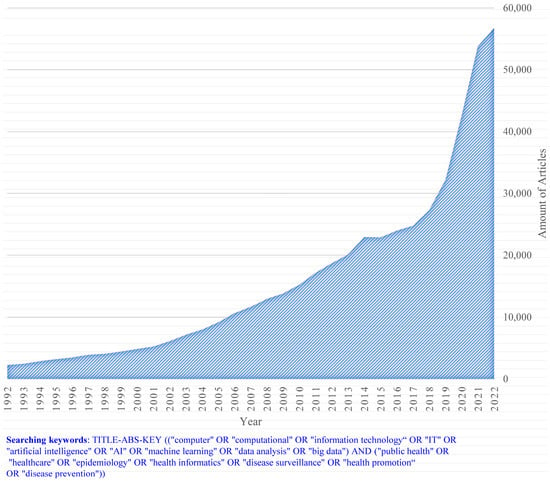
Figure 1.
Application of computer-related subjects in the public health from 1992–2022.
However, the specific disciplines involved and the nature of their collaboration in this research remain unclear. Therefore, it is crucial to analyze interdisciplinary connections in research articles to comprehend the present state of interdisciplinary cooperation during the pandemic. Evaluating whether computer science effectively fulfills its role in epidemic management is yet to be determined, and conducting relevant analyses based on literature is vital for gaining insights into the current state of interdisciplinary integration during COVID-19.
Scholars have extensively examined the trend of multidisciplinary in scientific publications using various methods, resulting in a substantial body of research in this field. Previous studies have primarily focused on assessing the extent of interdisciplinary efforts and the development of collaborative initiatives over time [10]. These endeavors have solidified multidisciplinary research as a crucial approach, leading to the transformation of knowledge structures and the deepening of expertise. For instance, Shi and Wang developed a measurement index for interdisciplinary research, utilizing data mining, processing, and analysis tools to study interdisciplinary literature [11]. They also utilize visualization tools like VOSviewer to summarize principles of knowledge sharing in interdisciplinary science.
Kochtanek proposed an algorithmic approach to generate a loosely structured set of documents based on references and citations [12]. This technique relies on a small selection of relevant documents to create a network of structured references and citations, with a focus on identifying pertinent documents for emerging interdisciplinary subject areas. Chakraborty explored the interdisciplinarity of computer science by using a large citation network to develop an automated unsupervised classification model. This model distinguishes between core and interdisciplinary fields within computer science, elucidating how interdisciplinary research emerges through the exchange of ideas across different fields [13]. Jie visually represented the research trajectory and outcomes of multidisciplinary research on the topic of “settlement” using literature data from the CNKI database [14]. This study emphasizes the importance of employing multidisciplinary integration research methodologies to cultivate new domains of settlement research. Evans introduced a novel text-based metric for measuring interdisciplinarity [15]. This metric assesses the extent to which a scholar’s work incorporates language from both distant and proximate disciplines. Validity evidence for the metric has been provided through testing on faculty members at Stanford University.
The aforementioned studies highlight the vital role of citation analysis in comprehending the present state of multidisciplinary research and tackling complex problems. Although literature-based disciplinary analysis is a prevalent research method, it is essential to recognize its limitations, such as small sample sizes and constrained timeframes. Moreover, some studies may lack a clear connection or relationship between disciplines, primarily relying on citation analysis, which might not fully capture the intricacies of interdisciplinary connections. Furthermore, some studies have utilized databases with strong content orientation, potentially introducing bias to the representation of disciplinary distribution.
Studies related to the application and fusion of computer science in medicine and public health span various key disciplines, including artificial intelligence and machine learning, neuroscience, medical and health sciences, physics, environmental sciences, climate change, and social sciences. These studies indicate a growing trend of interdisciplinary collaboration and research, particularly in the utilization of data-driven methods such as machine learning and artificial intelligence. These approaches address diverse issues across fields like environmental science, medical and health sciences, and social sciences [16,17,18,19,20,21,22,23,24,25,26,27].
Moreover, computer science and data science are increasingly being employed in traditional scientific domains, offering valuable tools for processing and analyzing vast datasets. This integration also introduces potential novel research methodologies and theories [16,17,18,19,20]. A growing number of studies in neuroscience and medicine are dedicated to unraveling the intricacies of brain function and developing innovative treatment approaches. This includes research into neural networks using advanced imaging technologies, coupled with the application of machine learning and data mining to forecast disease progression and enhance treatment strategies [22,23]. Additionally, in the realm of social sciences, scholars are actively utilizing data science techniques to examine complex societal issues, including subjects like discrimination, bias, and social inequality [16,17].
Nevertheless, despite promising results in discipline integration and application, the COVID-19 era necessitates a global perspective for a comprehensive analysis. The unparalleled scale and societal impact of this pandemic, unprecedented in prior studies, require real-time insights through rapid data processing and analysis. It is crucial to assess how COVID-19 accelerates digital transformation and amplifies reliance on data science and AI.
To address these constraints, our study employs social network analysis methods, incorporating chord diagrams, modularity analysis, and eigenvector centrality analysis to assess collaboration and integration among different disciplines. Our study aims to provide insights for policymakers on how to more effectively leverage interdisciplinary resources and strategies during health crises, particularly in promoting collaboration among different disciplines to address global health challenges like COVID-19.
2. Methodology
2.1. Data Source and Utilization
This research primarily collected from the Scopus database as a data source, chosen for its vast repository of academic articles spanning diverse disciplines, ensuring a comprehensive foundation for our analysis. The unique feature of Scopus, the SciVal Topic, was instrumental for our focus on COVID-19 research, allowing for a detailed examination of specific research areas. Articles related to COVID-19 from December 2019 to September 2022 was collected in this research. A program was created to scrape the disciplines and SciVal Topic of each article. The data was then processed and analyzed to discern patterns, trends, and interdisciplinary connections in COVID-19 research. Table 1 displays the number of articles collected each year (Referring to Appendix A for detailed information). A thorough breakdown of our data acquisition and analysis methodology can be found from the file hub https://github.com/lyf0703/covid-bib-analysis.

Table 1.
Number of articles collected in each year.
2.2. Overall Description on the Data and Procedures
A total of 240,509 articles underwent examination, offering a comprehensive global perspective on the subject. To avoid duplication with already published articles and ensure the accuracy of the included ones, preprints and arXiv articles were excluded for consistent disciplinary classification. Statistical analysis was conducted to categorize the research themes related to COVID-19. Additionally, social network analysis was applied to explore the interdisciplinary nature of various disciplines in studying COVID-19-related issues. The Louvain method was utilized to investigate clustering patterns and the trend of intersections among these disciplines. The process for reference retrieval and categorization is illustrated in Figure 2.
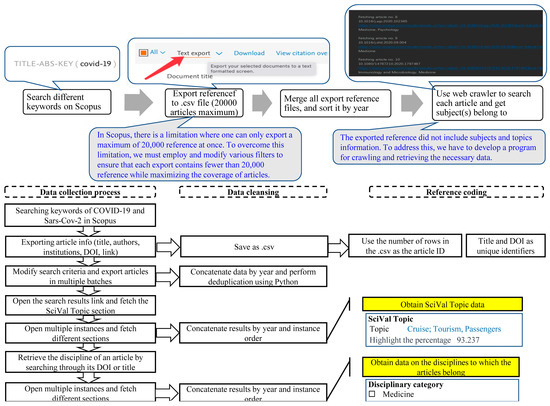
Figure 2.
The process of retrieving and handling reference data: including data collection, cleaning, and reference coding.
2.3. Approaches to Retrieve, Process, and Analyze Reference Data
2.3.1. Database Selection
This study primarily relies on Scopus as the main database, supplemented by searches in other academic databases such as PubMed, Google Scholar, and Web of Science. Manual searches were also conducted when necessary. Scopus, chosen for its valuable SciVal Topic feature, facilitates the analysis of COVID-19 research by enabling exploration of diverse research topics. The decision to avoid additional databases like PubMed, Google Scholar, and Web of Science aims to maintain simplicity in creating interdisciplinary networks, considering potential variations in disciplinary classification criteria. Scopus’ broad coverage across natural science, engineering, healthcare, and social science ensures a comprehensive understanding of the current COVID-19 research landscape.
2.3.2. Data Collection
Articles retrieved for this study were classified by year (2019, 2020, 2021, and 2022). The Scopus citation export feature was utilized to extract essential information, including article titles, authors, institutions, and DOIs. DOIs and article titles served as the primary means of identification. To overcome Scopus’s limitation of exporting 20,000 articles at once, we adjusted search criteria, filtered by country or region of affiliation, and exported data in multiple batches. After the full export, data were grouped by year. A Python script was employed for deduplication to address potential duplicate entries from articles affiliated with multiple countries or regions. Specifically, our study started with incorporating multiple previously saved CSV files using the Pandas library in Python, followed by employing the “drop_duplicates()” method within Pandas to deduplicate the data. To collect SciVal Topic information, we opened search result links by year and used a coded program to extract the SciVal section from webpages. Multiple program instances ran concurrently for efficiency, each responsible for fetching different sections. After data retrieval, we integrated scattered files by year. For determining article disciplines, Scopus doesn’t explicitly specify this information. However, during search result filtering, we selected relevant disciplines by finding unique search results using the article’s DOI, captured with a custom web scraping program. This typically yielded 1–3 disciplines. In cases without a DOI, searches based on the article’s title were conducted. To ensure result uniqueness, we manually reviewed the operation log. The process for capturing and saving article disciplines mirrored the SciVal Topic approach, using multiple instances and consolidating results by year.
2.3.3. Data Cleansing and Reference Coding
The reference information from the search results was initially exported in CSV format, containing article details such as titles, authors, institutions, and DOIs. Due to Scopus’ export limitation of 20,000 articles at a time, various filtering criteria were applied to keep the exported entries below this threshold while ensuring comprehensive coverage. After completing the reference export, a custom program was used for deduplication. In terms of reference coding, the row numbers in CSV files serve as unique identifiers, eliminating the need for additional encoding. Furthermore, the combination of DOI and article titles facilitated accurate identification and location of individual articles.
2.3.4. Discipline Ranking
In this study, we compiled a tally of the SciVal topics covered in the articles and performed rankings based on the count and percentage of SciVal topics within the articles for each year. By conducting both horizontal (year-wise) and vertical (based on the number and percentage rankings) analyses of these topics, we gained insights into the extent of involvement of various disciplines in COVID-19 research. This approach enabled the identification of predominant disciplines or topics in the research landscape.
2.3.5. “Inter” Degree and Integration Patterns among Involved Disciplines
Social Network Analysis (SNA), a mathematical and computational method representing entities as nodes and their relationships as edges in a network, was employed to analyze connection patterns between disciplines. The network structure in the SNA allows for the examining various types of relationships and interactions among entities (agents). In this study, each article could be associated with one or more relevant disciplines, establishing relationships between them. Disciplines served as nodes (vertices), and edges connecting them were defined as follows: for articles with one related topic, no edge was created, but the vertex’s degree increased; for articles with two related topics, an edge was created between the two vertices, increasing each vertex’s degree; and for articles with multiple related topics, pairwise combinations generated edges, increasing each vertex’s degree. This social network was constructed as an undirected network to represent discipline relationships.
In this study, Eigenvector Centrality was used to assess the significance and relationship patterns among disciplines. Unlike Degree Centrality, which only considers the number of direct connections, Eigenvector Centrality takes into account both the number and importance of connected nodes. It assigns scores to all vertices based on this principle, with higher scores indicating connections to other highly scored vertices. In our research, we used Eigenvector Centrality to gauge a discipline’s importance in the discipline network, where a high score implies a central role with strong connections to multiple disciplines. This centrality measure relies on adjacency matrices for calculation [28].
For a given graph G: = (V, E) with |V| vertices, let A = (av,t) be the adjacency matrix, if vertex v is linked to vertex t, and av,t = 0, otherwise av,t = 1, the relative centrality score, xv of vertex v can be defined by Equation (1):
where M(v) is the set of neighbors of v and λ is a constant. In this research, with rearrangement, it can be represented in vector notation as an eigenvector equation:
2.3.6. Examining Trends in the Integration of Disciplines
To gain a comprehensive understanding of how disciplines cluster together and how these patterns evolve over time, we conducted a community analysis. This analysis aimed to reveal tightly-knit clusters of disciplines and track the changes in these communities. We utilized a modularity approach, a concept from graph theory, to measure the network’s capacity to be divided into smaller modules or communities. In our research, we applied modularity optimization techniques, including the Louvain method, to uncover the community structure of disciplines.
The Louvain method, a community detection algorithm, excels in handling large networks and identifies natural clusters within a network. It operates in two stages: first, identifying smaller communities by locally optimizing modularity, and then, aggregating vertices from the same community to create a new network [29]. It is important to note that the Louvain method is a heuristic algorithm, striving to identify the community partition that maximizes modularity but does not guarantee finding the global optimum. Nonetheless, it performs exceptionally well in practice. These steps can be repeated iteratively until maximum modularity is achieved. Previous studies have demonstrated the method’s high accuracy in identifying community structures. In our research, we leverage the Louvain method to uncover community structures within the discipline network, shedding light on the integration patterns among different disciplines.
To explore trends in the integration of involved disciplines, we compared changes in communities across different years. To mitigate the impact of varying article quantities and the dominance of medical-related articles, we maintained a consistent number of articles and an identical number of disciplines within each article annually. This was achieved by randomizing the arrangement of disciplines with equal frequency. Subsequently, we calculated Eigenvector Centrality and modularity, comparing these results with the original findings to assess whether the combination patterns were influenced by article quantity or researchers’ awareness.
By employing these methods, our research addresses inquiries about discipline involvement, distribution, relationships, multidisciplinary integration, and practical implications. The expected research outcomes will provide a clear representation of interaction and collaboration patterns among disciplines in COVID-19 related research and how these patterns evolve over time. These insights enhance our comprehension of how disciplines cooperate and merge when confronting a global public health challenge, shedding light on the effectiveness of such cooperation and integration.
3. Results
3.1. Statistical Examination of Topics and Shifts over Time
In the study, we gathered and tallied the SciVal topics from each article for each year. In 2020, there were 7676 topics involved, 14,990 topics in 2021, and 12,372 topics in 2022. Due to article length limitations, Table 2, Table 3 and Table 4 only display representative data. In each table, “Rank” indicates the ranking of a specific topic for that year, “Degree” reflects how frequently the topic was mentioned, and “Percentage” signifies the proportion of that topic within the year. Given variations in the number of topics and articles, our primary focus for comparison will be on the rankings for each year.

Table 2.
Topics involved in the year 2020.

Table 3.
Topics involved in the year 2021.

Table 4.
Topics involved in the year 2022.
Between 2020 and 2022, notable trends emerged in COVID-19 research. “Nasopharyngeal swabs” and “serologic tests” consistently took precedence, emphasizing the crucial roles of virus detection and identification techniques. However, the focus shifted from “radiological findings” and “clinical features”, dominant in 2020, reflecting the evolving understanding of COVID-19. Instead, “vaccine hesitancy” and the “anti-vaccination movement” gained increasing prominence, mirroring the growing importance of vaccination promotion and public attitudes. Concerns about mental health persisted, with “mindfulness” and “psychological support” maintaining significance. The rising presence of “deep learning” indicated heightened interest in AI applications, albeit with a relatively lower ranking. Topics like “social media”, “racism”, and “Twitter” fluctuated but remained pertinent, highlighting their roles in information dissemination and addressing pandemic-related racism. In contrast, “ARIMA” and “mathematical modeling” saw reduced importance, potentially indicating decreased application in research as the pandemic evolved.
These data illuminate public concerns related to COVID-19 and the challenges faced by the public. The consistent attention to psychological support and mindfulness underscores the severe impact of the pandemic on mental health and the need for psychological assistance. The emergence of topics like vaccine hesitancy and the anti-vaccination movement during vaccination promotion signals public skepticism and resistance. The increasing interest in racism, social media, and Twitter reflects researchers’ exploration of social and cultural factors affecting COVID-19 transmission and public health responses. Policymakers and public health professionals can leverage these insights to better address public needs and challenges.
While this statistical analysis uncovers shifts in public interest regarding COVID-19 research topics, it falls short of providing a complete elucidation of the involvement of different disciplines or changes in interdisciplinary integration trends. Social Network Analysis (SNA) was employed to obtain a comprehensive understanding of these aspects, including which disciplines actively participate in COVID-19 research, their interaction patterns, and the evolving trends in collaboration. Through SNA-assisted analysis, a more profound comprehension of the roles and impacts of different disciplines in responding to the COVID-19 pandemic and the dynamic evolution of interdisciplinary collaborations during the crisis can be achieved.
3.2. Assessment of Present Disciplinary Integration
In Figure 3, the chord diagram visually represents how academic disciplines interact and engagement levels of academic disciplines by analyzing the retrieved COVID-19-related articles. A chord diagram is a chart type well-suited for analyzing intricate data relationships, particularly when visualizing bidirectional or undirected connections between different entities or categories and data flow. It features a circular layout where elements or entities are positioned around the perimeter, and the connections or relationships between them are represented as curved lines or “chords”. In our chord diagram, each vertex denotes a discipline, and the chords linking any pair of vertices represent the relationships between these disciplines. accommodate varying discipline name lengths, we use letters from A to ZA to symbolize different disciplines. The outermost ring consists of a circular arrangement of disciplines sorted by their code numbers. Each segment on the outer ring corresponds to a discipline, subdivided into multiple colored-blocks, with their sizes proportional to the number of connections with other disciplines. Disciplines with more connections exhibit larger blocks. Meanwhile, the inner ring indicates the quantity of connections, with thicker chords denoting disciplines with more connections.
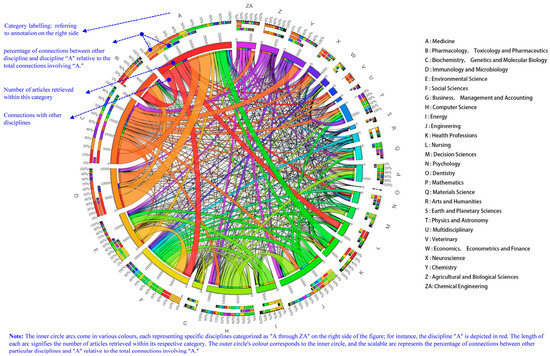
Figure 3.
Interdisciplinary network of disciplines in articles published from December 2019 to September 2022.
The chord diagram reveals that COVID-19 research predominantly revolves around disciplines such as medicine & biochemistry, genetics, and molecular biology, collectively contributing to nearly 20% of the research. In contrast, while disciplines like social science, environmental science, and engineering also play a role in pandemic research, their contributions are relatively modest compared to medicine. From an interdisciplinary perspective, the chord diagram illustrates that many fields are closely associated with medicine, including biochemistry, genetics, molecular biology, pharmacology, toxicology, immunology, and microbiology, all of which are pertinent to Medicine. Conversely, disciplines like social science, environmental science, and engineering, although reasonably significant in COVID-19 research, exhibit weaker connections with medicine and fewer instances of interdisciplinary interactions.
Contrary to the expectation that computer science would assume a more prominent role in pandemic research during this technology-driven era, it is noteworthy that while computer science maintains connections with other disciplines, particularly engineering, it has not established robust ties with medicine. This suggests that during large-scale public health crises, despite the widespread application of computer science, there remains a certain distance between this discipline and the core of medical research. Consequently, one can conclude that COVID-19 research during the pandemic still primarily revolves around medicine as the core discipline. Although interdisciplinary collaboration exists, there are variations in the modes and depths of collaboration among different disciplines. Notably, while there is a general societal expectation for high-tech disciplines like computer science to play a pivotal role in pandemic research, their actual integration into interdisciplinary studies has fallen short of the expected influence.
Figure 4, Figure 5 and Figure 6 display the networking of disciplines involved in the retrieved COVID-19-related articles. A social network graph or complex relationship graph provides an intuitive way to illustrate the connections between disciplines through the linking of points and lines. In our social network graph, nodes represent disciplines, and their size stands for the number of articles employing that discipline, with larger points denoting disciplines used in more articles. We set upper and lower size limits to ensure proportional scaling of the graph, avoiding overly small points that are hard to discern or excessively large points that might obscure other parts of the graph. To highlight clustering patterns among disciplines, we used the same color to label disciplines within the same discipline community. Each connecting line (edge) represents the association between two disciplines, with thicker lines indicating more combinations between these two disciplines.
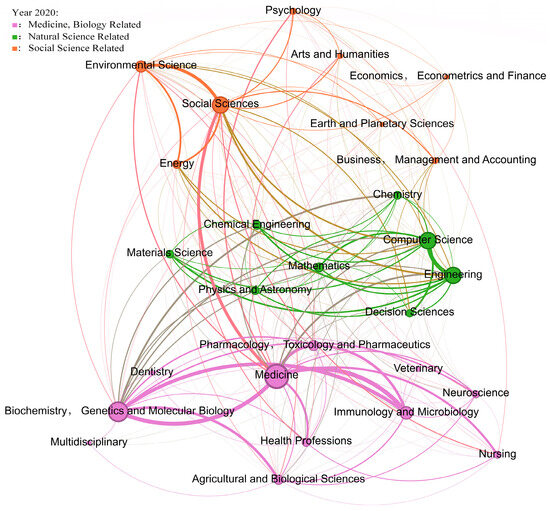
Figure 4.
Networking of disciplines involved in articles published in 2020. Note: Medical disciplines, such as biochemistry and immunology, exhibit a significant presence and strong connections. Engineering and computer science take the lead within the natural sciences, while social sciences and environmental science bridge the gap between humanities and the sciences. Notable associations are observed between agriculture and medicine, as well as between biochemistry and chemistry. However, the expected strong connection between computer science and medicine is not as prominent as anticipated.

Figure 5.
Networking of disciplines involved in articles published in 2021. Note: Although the medical field remains prominent, disciplines within the social sciences have outpaced natural sciences in terms of the number of publications. This shift reflects the significant influence of COVID-19 on society and the humanities. The pandemic has prompted cross-disciplinary collaborations, with fields like “energy” and “environmental science” becoming more interconnected with social sciences. This underscores the importance of multidisciplinary cooperation and research spanning various areas during health crises.
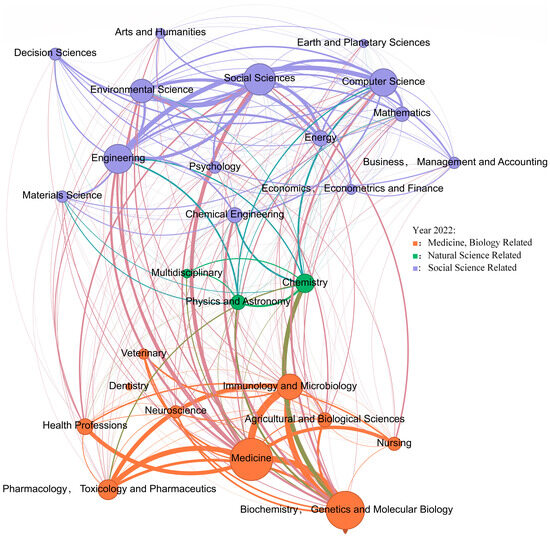
Figure 6.
Networking of disciplines involved in articles published in 2022. Note: Medicine continues to lead, with significant convergence between social and natural sciences.
In the process of classifying disciplinary communities, this study categorized the mentioned disciplines into three main groups based on their academic content: humanities and social sciences, natural sciences, and medicine. This classification reflects the fundamental characteristics and research domains of these disciplines. Although, in practical modularity analysis, some disciplines may span different communities due to the interdisciplinary nature of their research. Below is the classification for the three disciplinary communities: (1) humanities and social sciences: social sciences, arts and humanities, psychology, decision sciences, business & management & accounting, and economics, econometrics, and finance; (2) natural sciences: agricultural and biological sciences, engineering, environmental science, computer science, mathematics, chemical engineering, physics and astronomy, chemistry, materials science, earth and planetary sciences, energy, and other multidisciplinary; (3) medicine: medicine, biochemistry, genetics, and molecular biology, health professions, pharmacology, toxicology, and pharmaceutics, nursing, neuroscience, immunology and microbiology, veterinary, and dentistry. It’s important to note that this classification is based on the general understanding of disciplines and their primary research directions. However, the results of modularity analysis may show overlap and intersections between disciplines, and some disciplines may be assigned to communities outside of their designated categories. Therefore, the final identification of community types is based on the predominant type of disciplines within that community.
In Figure 4, three disciplinary communities are represented by colors: medicine (purple), social sciences (orange), and natural sciences (green). The social network analysis chart from 2020 highlights the prominence of the medical field and its associated areas, including biochemistry, genetics, molecular biology, immunology, and microbiology, as the most active and influential research domains. Furthermore, engineering and computer science play significant roles within the natural sciences, while social sciences and environmental science take center stage in the humanities.
According to the 2021 social network analysis chart in Figure 5, we observe that the disciplinary community divisions persisted in the realms of medicine-related, social science-related, and natural science-related disciplines. Medical-related fields remained the focal point of research, significantly outnumbering other domains. However, it is noteworthy that while the dominance of medical disciplines did not change significantly, key disciplines in social sciences slightly outnumbered those in the natural sciences. This reflects that COVID-19 is not merely a medical issue; it has garnered substantial attention in the social and humanities dimensions.
Furthermore, under the backdrop of the pandemic, there had been some interdisciplinary realignments occurred within these academic communities. Disciplines traditionally associated with natural sciences or engineering, such as “energy”, “environmental science”, and “earth and planetary sciences”, are now categorized under humanities in the social network chart. This might suggest that the impact of the pandemic in these fields is closely intertwined with social, cultural, and economic aspects. Particularly, the emerging triangular relationship between energy, environmental science, and social science could further substantiate the intricate interplay between energy research and environmental and social factors in the context of COVID-19.
It is evident that, one year later, medicine remained the predominant force, with social sciences also playing an undeniable role. This offers a new perspective, highlighting that the relationship and interactions between humans and technology in the context of large-scale health crises on a global scale might not be as straightforward as initially expected, and multidisciplinary integration and collaboration continue to be crucial.
In the social network analysis chart for 2022 (Figure 6), medicine remained the dominant field of study, particularly in key disciplines such as medicine, biochemistry, genetics, and molecular biology. However, a noteworthy shift had occurred at the intersection of social sciences and natural sciences during this year. We observed that social sciences had nearly “absorbed” much of what were originally domains of natural sciences, including computer sciences, environmental sciences, and engineering. This trend likely reflects a direct response to the impact of COVID-19 on global societal life, as many technological and natural science studies are directly related to the pandemic’s influence on daily living.
Furthermore, the natural sciences domain was now primarily composed of three disciplines: chemistry, physics and astronomy, and multidisciplinary. The latter exhibits its interdisciplinary nature, particularly in the context of pandemic research. While some connections persisted between medicine and social sciences, computer science, engineering, and environmental science, indicating cross-disciplinary collaboration, medicine remained a relatively independent field. Over the past three years, the results consistently show that medicine continues to dominate, followed by research in the social sciences. This trend not only reveals the direct influence of the pandemic on academic research but also underscores the significance of these disciplines in addressing a global health crisis.
3.3. Assessment on the Multidisciplinary Connections and Collaborations
Eigenvector centrality analysis was conducted, and scores were calculated for each year, aiming to identify trends over time (Table 5, Table 6 and Table 7). Table 8 demonstrates randomized eigenvector centrality scores for the years from 2020 to 2022 (Figure A3, Figure A4, Figure A5, Figure A6, Figure A7 and Figure A8 in Appendix A).

Table 5.
Eigenvector analysis for disciplines involved in articles published in 2020.

Table 6.
Eigenvector analysis for disciplines involved in articles published in 2021.

Table 7.
Eigenvector analysis for disciplines involved in article published in 2022.

Table 8.
Randomized eigenvector centrality scores for disciplines involved in articles published from 2020 to 2022.
In COVID-19 research, medicine consistently maintained the highest Eigenvector centrality score, underscoring its enduring centrality and profound impact on other disciplines. Agricultural and biological sciences saw a notable increase in eigenvector centrality scores from 2020 to 2022, signifying its growing influence. Social sciences maintained high centrality scores throughout the three years, particularly in areas like public health policy and social impacts. Environmental science held the highest Eigenvector centrality score in 2020, and while it dipped slightly in 2021 and 2022, it still maintained a significant presence. This highlights the enduring relevance of environmental factors in the context of the pandemic. Disciplines including computer science, engineering, biochemistry, genetics, and molecular biology all played essential roles in disease modeling, data analysis, and genetic research during the pandemic. Economics, econometrics, and finance gradually gained importance over time in pandemic impact research. Disciplines like nursing, immunology, and microbiology, although their eigenvector centrality scores were not significant at the beginning, witnessed increasing influence from 2020 to 2022.
In the context of the COVID-19 pandemic, certain disciplines like medicine, biology, and public health have gained higher eigenvector centrality scores in research due to their direct involvement in understanding the virus’s biological aspects, treatment, and prevention. Disciplines such as social sciences, economics, and finance have played crucial roles in addressing the pandemic’s societal, economic, and mental health impacts, despite having fewer research outputs compared to medicine or biology.
Environmental science initially had the highest centrality in 2020, likely because researchers were focused on understanding the virus’s origins and transmission in the environment. However, as our understanding of the virus evolved, the research focus shifted towards pandemic management and its societal and economic consequences, explaining the decline in environmental science’s centrality in the subsequent years.
Over time, disciplines like immunology, microbiology, and nursing have seen increased centrality, possibly driven by the ongoing nature of the pandemic, which required ongoing research on vaccines, immunity therapies, and patient care. The rise of agricultural and biological sciences in 2021 and 2022 could be attributed to their critical roles in virus research, vaccine development, and ensuring food supply stability during the pandemic.
Before the onset of COVID-19, disciplines related to computer science were highly esteemed in the realms of public health and medicine, with many scholars anticipating a pivotal role for them during the pandemic. However, the eigenvector centrality scores of these disciplines did not manifest the expected levels, possibly due to challenges in practical applications and integration with other fields. The pandemic highlighted difficulties in interdisciplinary collaboration, underscoring the need to address such challenges when dealing with global health crises.
As for the randomized results, they serve to assess the robustness and potential biases in the original findings. Shuffling connections between disciplines while keeping their degrees constant generates a null model, helping us gauge whether observed centrality results are statistically significant. In randomized results, all disciplines have centrality values approaching 1, indicating no significant differences between them under random conditions. This null model aids in bias identification and comparison between disciplines, emphasizing the genuine impact of their connections on centrality in the original results and highlighting the unique roles different disciplines play in understanding and addressing the COVID-19 pandemic.
3.4. Combination Patterns of Disciplines Involved in COVID-19-Related Articles
Centrality analysis aids in identifying key disciplines, while clustering analysis is essential for understanding combination patterns. In this study, modularity analysis was conducted to identify discipline communities for each year. To ensure unbiased comparisons and account for article numbers, randomization was carried out. The results showed that communities were not detected across all three years. The outcomes of the modularity analysis are presented in Table 9.

Table 9.
Discipline community identification using modularity analysis.
The community analysis using modularity revealed a classification of disciplines into three overarching groups: medical, biological, and health-related disciplines; natural sciences and engineering related disciplines; and social sciences, humanities, and business-related disciplines. These shifts in the aggregate discipline communities over the course of the COVID-19 pandemic provided insights into the interactions between different disciplines and how a global event like a pandemic drove interdisciplinary collaborations among academic fields.
The community consisting of medical, biological, and health-related disciplines remained relatively stable throughout the included years, possibly because these fields played a more direct role in understanding the disease and finding solutions independently. Notably, veterinary and dental sciences consistently belonged to this community, highlighting their enduring connections with disciplines in this community. The natural sciences and engineering-related community experienced significant changes. In 2020 and 2021, it encompassed disciplines like computer science, mathematics, and engineering, but by 2022, only chemistry and interdisciplinary studies remained, suggesting a potential shift in intra-community ties or increased collaboration with other disciplines. Social sciences, humanities, and business-related disciplines formed a separate community in 2020 and 2021, but in 2022, some disciplines previously classified under natural sciences and engineering joined, indicating a growing crossover between natural and social sciences to address complex societal issues as the pandemic evolved. Additionally, interdisciplinary studies moved between the three communities, reflecting its explicit role in bridging different fields during the pandemic.
The prolonged nature of the COVID-19 pandemic has a significantly influenced interdisciplinary research. Initially, Natural sciences led the way in understanding the disease and finding treatments. However, as time went on, social sciences began to focus on the broader societal, economic, educational, and mental health impacts of the pandemic. Moreover, as the pandemic evolved, the need for interdisciplinary collaboration grew, with disciplines like technology, engineering, and computer science potentially requiring much closer partnerships with social sciences to address complex societal challenges. The community analysis method itself might influence changes in interdisciplinary relationships. Moreover, due to changes in research approaches, issues, or collaborative partnerships, certain disciplines transitioned to other communities as community members evolved and changed.
4. Discussion and Conclusions
In the study’s results section, we have extensively elucidated the collaborative connections and intersections among diverse disciplines, laying a critical foundation for our discussions in the subsequent section. Through the lens of social network analysis, we have discerned the enduring centrality of the medical field in COVID-19 research, as well as the growing influence of disciplines like agriculture and biological sciences, social sciences, and environmental sciences over time. Furthermore, we have acknowledged the significant contributions of computer science, engineering, biochemistry, genetics, and molecular biology to areas such as data processing, model development, and genetic research.
Nevertheless, it is imperative to recognize that the process of interdisciplinary integration was not always smooth. Notably, the anticipated effects of computer science and engineering in their integrations and applications have not fully met expectations in the fields [1,30,31,32,33,34,35,36,37,38,39,40,41,42]. This situation necessitates us to consider the following essential questions: This situation necessitates us to consider the following essential questions. What challenges do we encounter in interdisciplinary research? Why do certain disciplines face difficulties in integration? And what strategies and pathways can enhance our ability to seamlessly integrate these fields?
The crux of addressing these questions lies in the acknowledgment that, although we now recognize the importance of interdisciplinary research in addressing the challenges presented by COVID-19, it is crucial to delve deeper into understanding how the integration of disciplines was accomplished. This involves exploring the potential obstacles and solutions that may emerge in the process. By engaging in a comprehensive discussion of these issues, we can formulate more pragmatic and targeted recommendations for advancing interdisciplinary research and better prepare ourselves to confront potential public health crises in the future.
4.1. On Advancing Interdisciplinary Degrees in Computer Science and Health
The application of computer science-related disciplines to the fields of medicine and biology undoubtedly holds great promise. In crucial areas such as gene sequencing, drug development, and the analysis of medical images, it plays a vital role in disease diagnosis and treatment. Carracedo-Reboredo and their colleagues emphasized that computer science, particularly machine learning techniques, have expedited the process of drug development [24]. Bhattamisra and co-authors explored the use of artificial intelligence and machine learning in the fields of medicine and biology, investigating their potential in predicting disease outbreaks, aiding diagnoses, improving drug research and development, and personalizing treatment approaches [19]. Medenica et al. discussed the applications of various advanced techniques such as deep learning models, machine learning methods, multivariate analysis, and artificial neural networks across diverse fields. These applications included embryo selection, predicting implantation potential, analyzing semen, and forecasting male infertility [42]. Cai and their team (2021) identified the promise of machine learning in constructing disease models for conditions like hypertension and heart failure [25]. Badawi et al. proposed that big data holds substantial potential within the medical domain. This potential extends to improving clinical practices, offering personalized treatment, and advancing medical research [43]. According to Danku and colleagues, artificial intelligence is progressively gaining significance in the prediction and diagnosis of cancer, with the potential to become extensively adopted in the future [44]. Mlodzinski et al. conducted a review investigating how machine learning could be used to tackle critical medical issues related to the lungs [22]. Within the field of biology, Keshner and her team delved into the potential uses of virtual reality (VR) in rehabilitation training, showcasing its various applications in physical, cognitive, and psychological rehabilitation [45].
However, rapid deployment of these technologies in response to public health emergencies could be challenging. Moreover, due to the inherent nature of medical research, these advancements require substantial time and resources for both experimental validation and clinical trials. Therefore, while computer science holds long-term promise in these domains, its immediate application in these fields may face practical constraints.
4.2. Challenges in “Interring” Disciplines
Interdisciplinary collaboration offers new perspectives and tools for tackling COVID-19 challenges. However, it comes with significant challenges and barriers. Studies have highlighted that the disparities in terminology and theoretical foundations among different poses obstacle to such cooperation [17,18,27,46,47,48].
Firstly, effective cross-discipline communication and understanding are vital yet challenging. Interdisciplinary research involves interaction among scholars from diverse backgrounds, each with its distinct professional terminology, thinking paradigm, conceptual framework, and theoretical foundations. This complexity hinders, inter-disciplinary communication, especially between disciplines like computer science and medicine, and humanities and social sciences. Bridging this gap requires substantial time and efforts to comprehend each other’s language, cognitive and thinking processes, and the adaptation of expertise to different domains. The use of a group model building process is imperative to establish a common and mutually understood framework [49]. Additionally, the integration of multiple disciplines should address issues related to data sharing and privacy protection to efficiently combine, aggregate, and analyze data across diverse fields.
Secondly, interdisciplinary studies involve handling substantial volumes of data, leading to challenges related to data quality and management. These challenges are compounded by variations in knowledge bases and available literature resources, complicating disciplinary integration further. Interdisciplinary research entails not only acquiring a diverse range of data processing and analysis skills but also ensuring the accuracy and reliability of the data itself. Moreover, it is crucial to establish an efficient data management system that facilitates data storage, retrieval, and sharing while addressing concerns related to data security and privacy protection [23,42,50,51,52]. Additionally, the standardization of data and processing protocol is essential to prevent compatibility issues arising from diverse theoretical frameworks across disciplines.
Although scholars have proposed valuable recommendations to promote data sharing in interdisciplinary research, obstacles hinder the successful implementation of these practices. Open data sharing may raise trust issues in the health-related field, as medical organizations may lack the necessary human resources and IT capabilities, as well as trust in secure digital data collection and usage, as noted by Mlodzinski et al. [22]. Medenica and colleagues warned that establishing open data platforms in reproductive medicine research could potentially lead to ethical and privacy issues. Adhering to ethical norms and safeguarding patient privacy and data security when utilizing AI in reproductive medicine is crucial [42]. When dealing with data coming from different sources and evaluated through different disciplinary lens, it is essential to recognize the intricate and varied nature of the information. Achieving full-fledged interdisciplinary integration is complex due to the necessity to piece together the various data sources from diverse fields to address the intricacies and diversities associated with specific health-related issues such as vaccine development and administration. Besides, professionals from different disciplines often emphasize distinct facets of data. For instance, experts in computer science and engineering may prioritize privacy concerns, while legal researchers might place more emphasis on matters of responsibility. These differing perspectives can undoubtedly influence their impartial assessment of the data’s effectiveness in addressing issues of interest.
4.3. Call for a Broader Thinking in Interdisciplinary Research within Health Studies
In academia, it is uncommon for an event or issue to stimulate extensive participation from multiple disciplines. Research pertaining to COVID-19 has undoubtedly generated a wealth of valuable insights and impetus for advancing interdisciplinary research, spanning concepts, methodologies, intellectual approaches, theories, frameworks, data integration and analysis, and pertinent considerations.
In the context of global health crises like COVID-19, interdisciplinary collaboration becomes particularly crucial. Such crises demand a multidimensional approach and necessitate experts from various disciplines to collaborate. However, despite being evident, the role of computer science in collaboration with medicine during this period has not fully met expectations. It is important to recognize that the potential of computer science in medicine is expected to grow with technological advancements.
Nevertheless, this challenge extends beyond technological aspects. Health-related research like COVID-19 is also a cultural and societal issue, testing how we balance technology with medicine and the humanities. Different academic perspectives may have varying views on this matter. It is crucial not to overly emphasize the role of technical disciplines like computer science alone but to recognize that their true value is maximized when closely integrated with medicine, humanities, and social sciences. For example, the adoption and application of technology are not just technical matters; they also involve reducing the cost of technology use, lowering entry barriers, and overcoming cultural barriers. In certain regions, high-tech solutions may face obstacles due to cultural and social factors. To address these issues, relevant disciplines can focus on lowering technology barriers, increasing technology education, improving economic strategies, and establishing feedback mechanisms, among other measures. Lowering technology barriers is a critical step in achieving technology fairness and accessibility. To make new technologies more accessible to a broader audience, we need to develop user-friendly tools and applications that even non-technical individuals can easily use. Additionally, targeted training and education are essential to ensure people in various regions have the necessary skills and knowledge.
To encourage technology adoption, providing economic incentives such as subsidies and discounts is an effective strategy. However, relying solely on technology and economic strategies is not sufficient; we also need a feedback mechanism to collect user feedback and suggestions in a timely manner, allowing continuous improvement and refinement of technology. This series of steps once again highlights the importance of interdisciplinary collaboration. Approaching the issue solely from a technological perspective is inadequate; we need experts from various disciplines to work together, integrating their expertise from multiple angles and levels to address problems and ensure that technological advancements truly serve society and people’s needs.
Additionally, community involvement is paramount in interdisciplinary research. Only when all parties—including scholars, medical professionals, engineers, and the public—actively participate can research outcomes be more practical, relevant, and directly beneficial to society. As interdisciplinary collaboration deepens, managing and mastering increasingly complex knowledge and information also becomes a challenge.
In summary, facing these challenges, the academic community needs to prioritize interdisciplinary collaboration, providing the necessary support and resources. This requires not only more funding but also increased publication opportunities for interdisciplinary research to encourage and drive further exploration in this area.
4.4. Theoretical and Practical Contributions
In this paper, our study explores the application and challenges of interdisciplinary research in addressing health-related issues, particularly in the context of COVID-19 research. In contrast to traditional bibliometric analyses, our research employs social network analysis methods, incorporating chord diagrams, modularity analysis, and eigenvector centrality analysis to assess collaboration and integration among different disciplines. Our study reveals that despite high expectations for computer science in the technology-driven era, its connection with medical research is not as close as anticipated, uncovering gaps and challenges in interdisciplinary fusion. Furthermore, our research emphasizes the importance of theoretical and methodological foundations between different disciplines when understanding and promoting interdisciplinary collaboration. These findings not only enrich the theoretical basis of interdisciplinary research but also provide new perspectives and tools for understanding and advancing interdisciplinary cooperation in the scientific field.
From a practical standpoint, the findings of our study hold significant implications for public health policy formulation, large-scale health crisis management, and fostering collaboration between disciplines. Our analytical results offer insights for policymakers on how to more effectively leverage interdisciplinary resources and strategies during health crises, particularly in promoting collaboration between different disciplines to address global health challenges like COVID-19. Additionally, by revealing the practical limitations of the application of computer science in medical research, our study highlights the necessity of integrating technology more effectively into the healthcare domain in the future. Our findings also contribute to raising public awareness and understanding of large-scale health crises, especially in areas such as vaccine hesitancy, psychological support, and health information dissemination through social media. In summary, our study not only provides meaningful insights for the academic community in interdisciplinary research but also offers practical guidance and recommendations for public health practices and policies.
4.5. Limitations and Future Research
Like many other research endeavors, this study is not exempt from limitations. Several limitations need to be acknowledged in this study. Firstly, variations in how disciplines and topics are defined across different academic databases were addressed primarily relying on Scopus as the main database, with supplementary verification from PubMed, Web of Science, and Google Scholar. Despite the benefit of consistency for disciplines and topics by only using Scopus, some disciplines might be underrepresented or overrepresented due to the database’s inclusion policies. Secondly, the articles included in this study were limited to those published between December 2019 and September 2022. Thirdly, the impacts of article quantity and quality on the discipline network were not fully addressed in this research. Fourthly, the categorization of the disciplines may not entirely align with the academic field categorization due to inherent rules in the selected databases’ categorization system. Fifthly, the Louvain method, while powerful for community detection in networks, has limitations. It can yield slightly different results on repeated runs due to its non-deterministic nature, impacting consistency. Additionally, its focus on modularity may miss the intricacies of interdisciplinary collaborations. Furthermore, due to the underdeveloped nature of the analysis framework and visualization approach for high-dimensional networks, dimensionality reduction was employed for articles involving more than two fields during the social network analysis phase, potentially leading to incomplete representation of interdisciplinary connections.
In future research, efforts can be directed towards reconciling disparities in discipline definitions across different databases, potentially allowing for the inclusion of a broader range of articles for analysis. Additionally, alternative methods beyond those employed in this study, such as citation analysis, authorship analysis, multi-layer network analysis, higher-dimensional network analysis and visualization approaches, and machine learning can be explored to delve deeper into the connectedness and interactions among different disciplines. The mounting use of machine learning [53,54], particularly the maturing field of generative large language models (GLLMs) [55,56], necessitates in-depth study of interdisciplinary collaborations. GLLMs, drawing expertise from at least 10–11 disciplines like linguistics, computer science, statistics, medicine, public health, behavioral science, law, ethics, and library science, hold immense potential for healthcare research. By nurturing collaboration across these disciplines, we can unlock the full potential of GLLMs and make them even more powerful and valuable tools for advancing healthcare.
Author Contributions
Y.L., S.L. (Shiyong Liu) designed research; Y.L. collected data and drafted paper; Y.L., J.Z. and W.Z. performed data analysis; S.L. (Shiyong Liu) wrote, edited, and polished the paper; A.Z., J.W. and S.L. (Sheng Li) provided technical guidance on the data analysis and contributed to the paper editing. All authors have read and agreed to the published version of the manuscript.
Funding
This research was supported by the MOE (Ministry of Education in China). Project of Humanities and Social Sciences (Project Number: 21YJAZH053).
Data Availability Statement
The data files, code file, and visualization files are stored at the portal https://github.com/lyf0703/covid-bib-analysis. For any inquiries concerning the data used in this study, please feel free to contact the corresponding author at liushiyong@bnu.edu.cn.
Conflicts of Interest
The authors declare no conflict of interest.
Appendix A
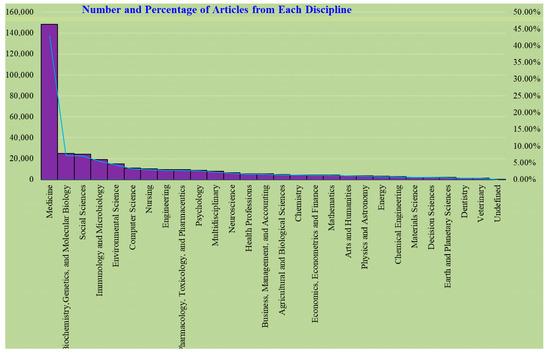
Figure A1.
Statistics on number and percentage articles from each discipline.
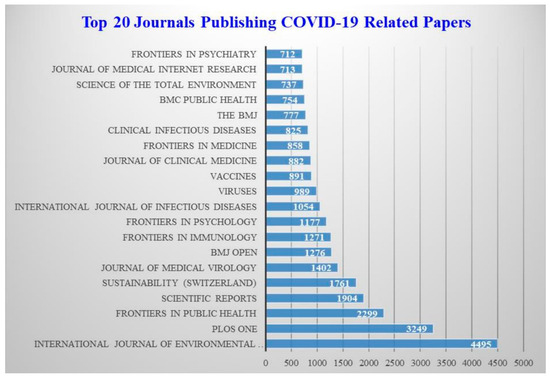
Figure A2.
Top 20 journals publishing articles related to COVID-19.
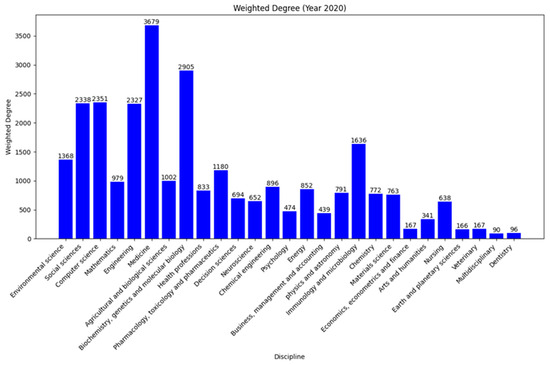
Figure A3.
Weighted degree of different disciplines in 2020.
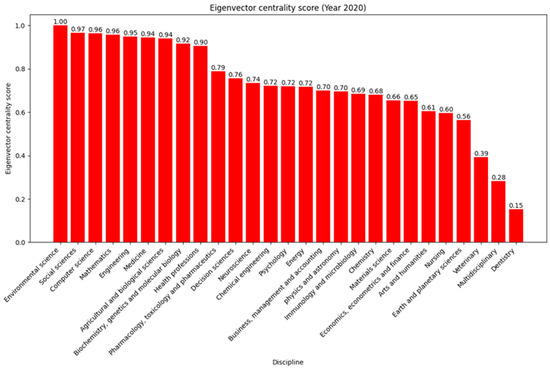
Figure A4.
Eigenvector centrality scores of different disciplines in 2020.
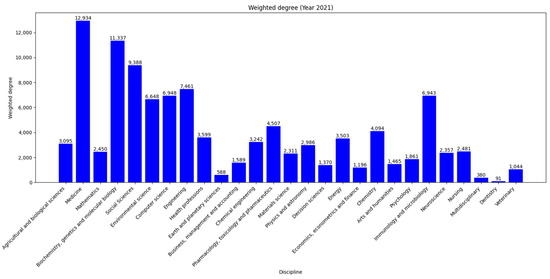
Figure A5.
Weighted degree of different disciplines in 2021.
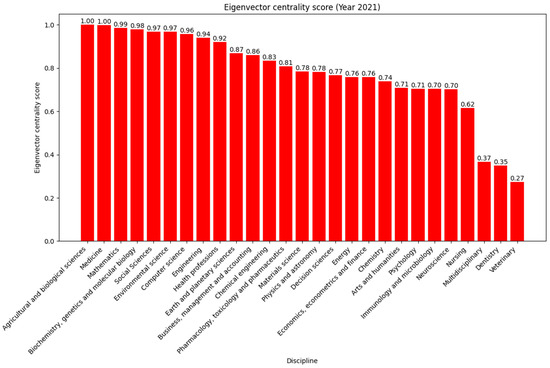
Figure A6.
Eigenvector centrality scores of different disciplines in 2021.
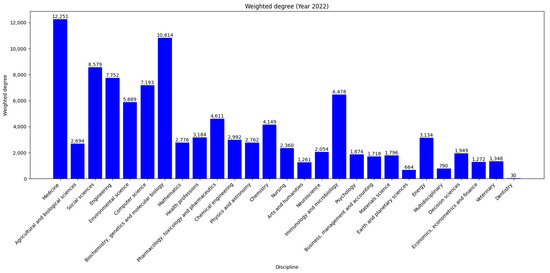
Figure A7.
Weighted degree of different disciplines in 2022.
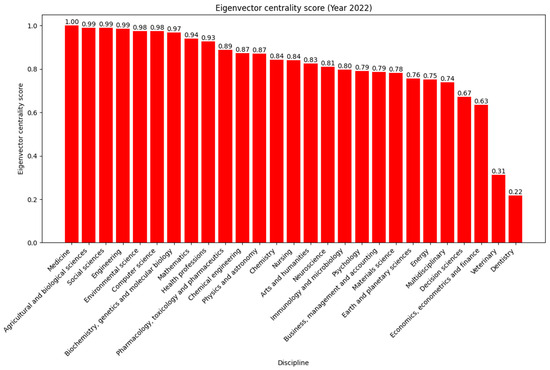
Figure A8.
Eigenvector centrality scores of different disciplines in 2022.
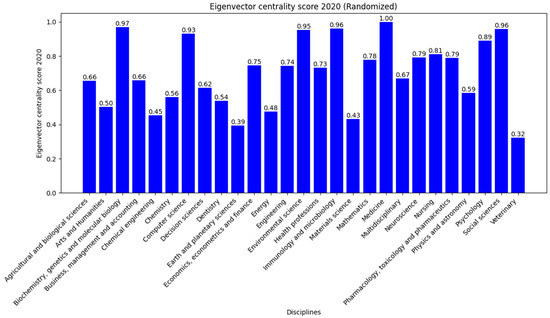
Figure A9.
Eigenvector centrality scores of different disciplines (with randomization of disciplines) in 2020.
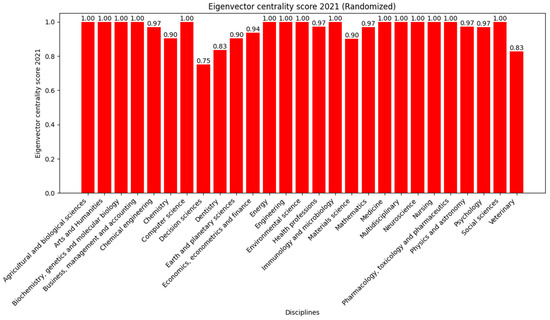
Figure A10.
Eigenvector centrality scores of different disciplines (with randomization of disciplines) in 2021.
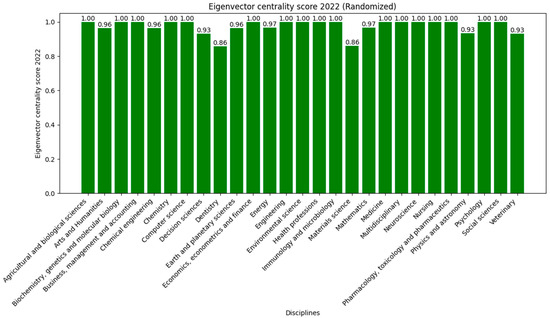
Figure A11.
Eigenvector centrality scores of different disciplines (with randomization of disciplines) in 2022.
References
- Soukup, T.; Lamb, B.W.; Arora, S.; Darzi, A.; Sevdalis, N.; Green, J.S. Successful strategies in implementing a multidisciplinary team working in the care of patients with cancer: An overview and synthesis of the available literature. J. Multidiscip. Healthc. 2018, 11, 49–61. [Google Scholar] [CrossRef] [PubMed]
- Bodin, Ö. Collaborative environmental governance: Achieving collective action in social-ecological systems. Science 2017, 357, eaan1114. [Google Scholar] [CrossRef] [PubMed]
- Landers, M.F.; Weaver, R.; Tompkins, F.M. Interdisciplinary collaboration in higher education: A matter of attitude. Action Teach. Educ. 1990, 12, 25–30. [Google Scholar] [CrossRef]
- Reeves, S.; Pelone, F.; Harrison, R.; Goldman, J.; Zwarenstein, M. Interprofessional collaboration to improve professional practice and healthcare outcomes. Cochrane Database Syst. Rev. 2017, 6, CD000072. [Google Scholar] [CrossRef] [PubMed]
- Borrill, C.; West, M.; Shapiro, D.; Rees, A. Team working and effectiveness in health care. Br. J. Health Care Manag. 2000, 6, 364–371. [Google Scholar] [CrossRef]
- Kivits, J.; Ricci, L.; Minary, L. Interdisciplinary research in public health: The ‘why’ and the ‘how’. J. Epidemiol. Community Health 2019, 73, 1061–1062. [Google Scholar] [CrossRef] [PubMed]
- Zgheib, R.; Chahbandarian, G.; Kamalov, F.; El Messiry, H.; Al-Gindy, A. Towards an ML-based semantic IoT for pandemic management: A survey of enabling technologies for COVID-19. Neurocomputing 2023, 528, 160–177. [Google Scholar] [CrossRef]
- Budd, J.; Miller, B.S.; Manning, E.M.; Lampos, V.; Zhuang, M.; Edelstein, M.; Rees, G.; Emery, V.C.; Stevens, M.M.; Keegan, N.; et al. Digital technologies in the public-health response to COVID-19. Nat. Med. 2020, 26, 1183–1192. [Google Scholar] [CrossRef]
- Ward, T.; Johnsen, A.; Ng, S.; Chollet, F. Forecasting SARS-CoV-2 transmission and clinical risk at small spatial scales by the application of machine learning architectures to syndromic surveillance data. Nat. Mach. Intell. 2022, 4, 814–827. [Google Scholar] [CrossRef]
- Zhao, Y.; Liu, L.; Zhang, C. Is coronavirus-related research becoming more interdisciplinary? A perspective of co-occurrence analysis and diversity measure of scientific articles. Technol. Forecast. Soc. Chang. 2022, 175, 121344. [Google Scholar] [CrossRef]
- Shi, Y.; Wang, Y. Research on the rules of scientists’ knowledge sharing based on interdisciplinary measurement. Procedia Comput. Sci. 2022, 199, 657–664. [Google Scholar] [CrossRef]
- Kochtanek, T. Document clustering, using macro retrieval techniques. J. Am. Soc. Inf. Sci. 1983, 34, 356–359. [Google Scholar] [CrossRef]
- Chakraborty, T.; Kumar, S.; Reddy, M.D.; Kumar, S.; Mukherjee, A. Automatic classification and analysis of interdisciplinary fields in computer sciences. In Proceedings of the 2013 International Conference on Social Computing, Alexandria, VA, USA, 8–14 September 2013; IEEE: Washington, DC, USA, 2013; pp. 180–187. [Google Scholar]
- Jie, Y. Bibliometric visualization analysis on spatiotemporal distribution characteristics of settlement. Bol. Tec./Tech. Bull. 2017, 55, 20–26. [Google Scholar]
- Evans, E.D. Measuring interdisciplinarity using text. Socius Sociol. Res. Dyn. World 2016, 2, 2378023116654147. [Google Scholar] [CrossRef]
- Karampela, M.; Isomursu, M.; Porat, T.; Maramis, C.; Lehocki, F. the extent and coverage of current knowledge of connected health: Systematic mapping study. J. Med. Internet Res. 2019, 21, e14394. [Google Scholar] [CrossRef]
- Liu, D.; Cheng, D.; Houle, T.T.; Chen, L.; Zhang, W.; Deng, H. Machine learning methods for automatic pain assessment using facial expression information: Protocol for a systematic review and meta-analysis. Medicine 2018, 97, e13421. [Google Scholar] [CrossRef] [PubMed]
- Alber, M.; Buganza Tepole, A.; Cannon, W.R.; De, S.; Dura-Bernal, S.; Garikipati, K.; Karniadakis, G.; Lytton, W.W.; Perdikaris, P.; Petzold, L.; et al. Integrating machine learning and multiscale modeling—Perspectives, challenges, and opportunities in the biological, biomedical, and behavioral sciences. NPJ Digit. Med. 2019, 2, 115. [Google Scholar] [CrossRef] [PubMed]
- Bhattamisra, S.K.; Banerjee, P.; Gupta, P.; Mayuren, J.; Patra, S.; Candasamy, M. Artificial intelligence in pharmaceutical and healthcare research. Big Data Cogn. Comput. 2023, 7, 10. [Google Scholar] [CrossRef]
- Murray, E.; Goodfellow, H.; Bindman, J.; Blandford, A.; Bradbury, K.; Chaudhry, T.; Fernandez-Reyes, D.; Gomes, M.; Hamilton, F.L.; Heightman, M.; et al. Development, deployment and evaluation of digitally enabled, remote, supported rehabilitation for people with long COVID-19 (Living With COVID-19 Recovery): Protocol for a mixed-methods study. BMJ Open 2022, 12, e057408. [Google Scholar] [CrossRef]
- Fox, J.; Cooper, R.; Glasspool, D. A canonical theory of dynamic decision-making. Front. Psychol. 2013, 4, 150. [Google Scholar] [CrossRef]
- Mlodzinski, E.; Stone, D.J.; Celi, L.A. Machine learning for pulmonary and critical care medicine: A narrative review. Pulm. Ther. 2020, 6, 67–77. [Google Scholar] [CrossRef] [PubMed]
- Saldanha, L.; Langel, Ü.; Vale, N. In silico studies to support vaccine development. Pharmaceutics 2023, 15, 654. [Google Scholar] [CrossRef] [PubMed]
- Carracedo-Reboredo, P.; Liñares-Blanco, J.; Rodríguez-Fernández, N.; Cedrón, F.; Novoa, F.J.; Carballal, A.; Maojo, V.; Pazos, A.; Fernandez-Lozano, C. A review on machine learning approaches and trends in drug discovery. Comput. Struct. Biotechnol. J. 2021, 19, 4538–4558. [Google Scholar] [CrossRef] [PubMed]
- Cai, A.; Zhu, Y.; Clarkson, S.A.; Feng, Y. The use of machine learning for the care of hypertension and heart failure. JACC Asia 2021, 1, 162–172. [Google Scholar] [CrossRef] [PubMed]
- Badawi, O.; Brennan, T.; Celi, L.A.; Feng, M.; Ghassemi, M.; Ippolito, A.; Johnson, A.; Mark, R.G.; Mayaud, L.; Moody, G.; et al. Making big data useful for health care: A summary of the inaugural mit critical data conference. JMIR Med. Inform. 2014, 2, e22. [Google Scholar] [CrossRef]
- Michie, S.; Yardley, L.; West, R.; Patrick, K.; Greaves, F. Developing and evaluating digital interventions to promote behavior change in health and health care: Recommendations resulting from an international workshop. J. Med. Internet Res. 2017, 19, e232. [Google Scholar] [CrossRef] [PubMed]
- Bursztyn, M.; Purushothaman, S. Interdisciplinary and transdisciplinary scholarship for a civilisation in distress: Questions for and from the Global South. Glob. Soc. Chall. J. 2022, 1, 94–114. [Google Scholar] [CrossRef]
- Dalton, A.; Wolff, K.; Bekker, B. Interdisciplinary research as a complicated system. Int. J. Qual. Methods 2022, 21, 1–13. [Google Scholar] [CrossRef]
- D’Este, P.; Robinson-García, N. Interdisciplinary research and the societal visibility of science: The advantages of spanning multiple and distant scientific fields. Res. Policy 2023, 52, 104609. [Google Scholar] [CrossRef]
- Gewin, V. Interdisciplinary research: Break out. Nature 2014, 511, 371–373. [Google Scholar] [CrossRef]
- Lynch, J. It’s not easy being interdisciplinary. Int. J. Epidemiol. 2006, 35, 1119–1122. [Google Scholar] [CrossRef] [PubMed]
- Cox, L.S.; Faragher, R.G. Linking interdisciplinary and multiscale approaches to improve healthspan—A new UK model for collaborative research networks in ageing biology and clinical translation. Lancet Healthy Longev. 2022, 3, e318–e320. [Google Scholar] [CrossRef]
- Morss, R.E.; Lazrus, H.; Demuth, J.L. The “inter” within interdisciplinary research: Strategies for building integration across fields. Risk Anal. 2021, 41, 1152–1161. [Google Scholar] [CrossRef] [PubMed]
- Porter, A.; Rafols, I. Is science becoming more interdisciplinary? Measuring and mapping six research fields over time. Scientometrics 2009, 81, 719–745. [Google Scholar] [CrossRef]
- Robertson, D.W.; Martin, D.K.; Singer, P.A. Interdisciplinary research: Putting the methods under the microscope. BMC Med. Res. Methodol. 2003, 3, 20. [Google Scholar] [CrossRef] [PubMed]
- Shaman, J.; Solomon, S.; Colwell, R.R.; Field, C.B. Fostering advances in interdisciplinary climate science. Proc. Natl. Acad. Sci. USA 2013, 110 (Suppl. 1), 3653–3656. [Google Scholar] [CrossRef] [PubMed]
- Smye, S.W.; Frangi, A.F. Interdisciplinary research: Shaping the healthcare of the future. Future Healthc. J. 2021, 8, e218–e223. [Google Scholar] [CrossRef]
- Solomon, G.E.; Carley, S.; Porter, A.L. How multidisciplinary are the multidisciplinary journals Science and Nature? PLoS ONE 2016, 11, e0152637. [Google Scholar] [CrossRef] [PubMed]
- Weart, S. Rise of interdisciplinary research on climate. Proc. Natl. Acad. Sci. USA 2013, 110 (Suppl. 1), 3657–3664. [Google Scholar] [CrossRef]
- Medenica, S.; Zivanovic, D.; Batkoska, L.; Marinelli, S.; Basile, G.; Perino, A.; Cucinella, G.; Gullo, G.; Zaami, S. The future is coming: Artificial intelligence in the treatment of infertility could improve assisted reproduction outcomes—The value of regulatory frameworks. Diagnostics 2022, 12, 2979. [Google Scholar] [CrossRef]
- Danku, A.E.; Dulf, E.H.; Banut, R.P.; Silaghi, H.; Silaghi, C.A. Cancer diagnosis with the aid of artificial intelligence modeling tools. IEEE Access 2022, 10, 20816–20831. [Google Scholar] [CrossRef]
- Keshner, E.A.; Weiss, P.T.; Geifman, D.; Raban, D. Tracking the evolution of virtual reality applications to rehabilitation as a field of study. J. NeuroEng. Rehabil. 2019, 16, 76. [Google Scholar] [CrossRef] [PubMed]
- Herre, H.; Hoehndorf, R.; Kelso, J.; Loebe, F.; Schulz, S. OBML—Ontologies in biomedicine and life sciences. J. Biomed. Semant. 2011, 2 (Suppl. 4), 1–6. [Google Scholar] [CrossRef]
- Leary, A.; Punshon, G. Determining acute nurse staffing: A hermeneutic review of an evolving science. BMJ Open 2019, 9, e025654. [Google Scholar] [CrossRef] [PubMed]
- Hahn, W.; Schütte, K.; Schultz, K.; Wolkenhauer, O.; Sedlmayr, M.; Schuler, U.; Eichler, M.; Saptarshi Bej, S.; Wolfien, M. Contribution of synthetic data generation towards an improved patient stratification in palliative care. J. Pers. Med. 2022, 12, 1278. [Google Scholar] [CrossRef]
- Mannheimer, J.D.; Duval, D.L.; Prasad, A.; Gustafson, D.L. A systematic analysis of genomics-based modeling approaches for prediction of drug response to cytotoxic chemotherapies. BMC Med. Genom. 2019, 12, 87. [Google Scholar] [CrossRef]
- Vennix, J.A. Group model-building: Tackling messy problems. Syst. Dyn. Rev. 1999, 15, 379–401. [Google Scholar] [CrossRef]
- O’Mara-Eves, A.; Thomas, J.; McNaught, J.; Miwa, M.; Ananiadou, S. Using text mining for study identification in systematic reviews: A systematic review of current approaches. Syst. Rev. 2015, 4, 5. [Google Scholar] [CrossRef] [PubMed]
- Da Silva Horsley, T.; Singh, D.; Da Silva, E.; Ly, V.; Thomas, B.; Daniel, R.C.; Chagal-Feferkorn, K.A.; Iantomasi, S.; White, K.; Kent, A.; et al. Legal concerns in health-related artificial intelligence: A scoping review protocol. Syst. Rev. 2022, 11, 123. [Google Scholar] [CrossRef]
- Negre, C.F.; Morzan, U.N.; Hendrickson, H.P.; Pal, R.; Lisi, G.P.; Loria, J.P.; Rivalta, I.; Ho, J.; Batista, V.S. Eigenvector centrality for characterization of protein allosteric pathways. Proc. Natl. Acad. Sci. USA 2018, 115, E12201–E12208. [Google Scholar] [CrossRef]
- Blondel, V.D.; Guillaume, J.-L.; Lambiotte, R.; Lefebvre, E. Fast unfolding of communities in large networks. J. Stat. Mech. Theory Exp. 2008, 2008, P10008. [Google Scholar] [CrossRef]
- Chakraborty, C.; Bhattacharya, M.; Pal, S.; Lee, S.-S. From machine learning to deep learning: An advances of the recent data-driven paradigm shift in medicine and healthcare. Curr. Res. Biotechnol. 2023, 7, 100164. [Google Scholar] [CrossRef]
- Javaid, M.; Haleem, A.; Singh, R.P.; Suman, R.; Rab, S. Significance of machine learning in healthcare: Features, pillars and applications. Int. J. Intell. Netw. 2022, 3, 58–73. [Google Scholar] [CrossRef]
- Peng, C.; Yang, X.; Chen, A.; Smith, K.E.; PourNejatian, N.; Costa, A.B.; Martin, C.; Flores, M.G.; Zhang, Y.; Magoc, T.; et al. A study of generative large language model for medical research and healthcare. NPJ Digit. Med. 2023, 6, 210. [Google Scholar] [CrossRef]
- Clusmann, J.; Kolbinger, F.R.; Muti, H.S.; Carrero, Z.I.; Eckardt, J.-N.; Laleh, N.G.; Löffler, C.M.L.; Schwarzkopf, S.C.; Unger, M.; Veldhuizen, G.P.; et al. The future landscape of large language models in medicine. Commun. Med. 2023, 3, 141. [Google Scholar] [CrossRef]
Disclaimer/Publisher’s Note: The statements, opinions and data contained in all publications are solely those of the individual author(s) and contributor(s) and not of MDPI and/or the editor(s). MDPI and/or the editor(s) disclaim responsibility for any injury to people or property resulting from any ideas, methods, instructions or products referred to in the content. |
© 2024 by the authors. Licensee MDPI, Basel, Switzerland. This article is an open access article distributed under the terms and conditions of the Creative Commons Attribution (CC BY) license (https://creativecommons.org/licenses/by/4.0/).